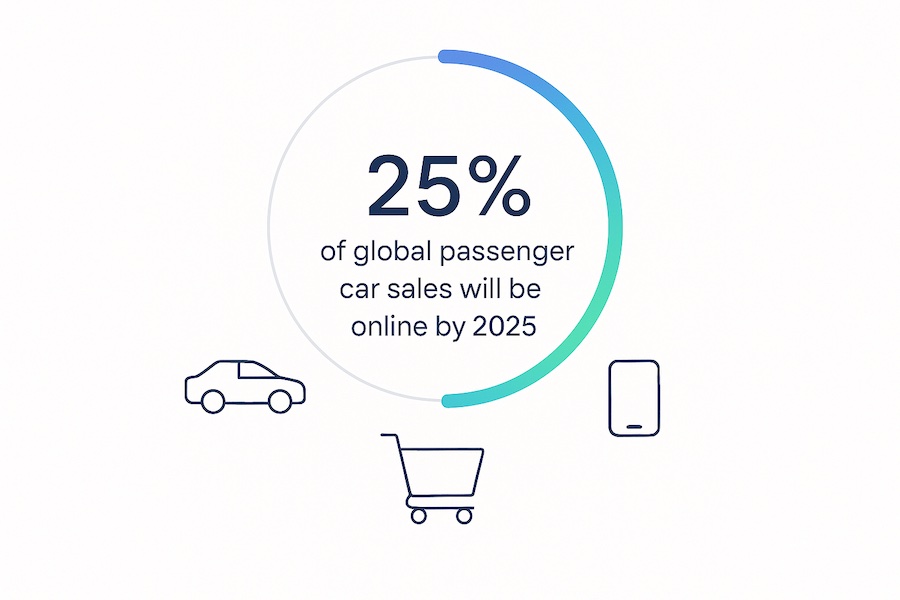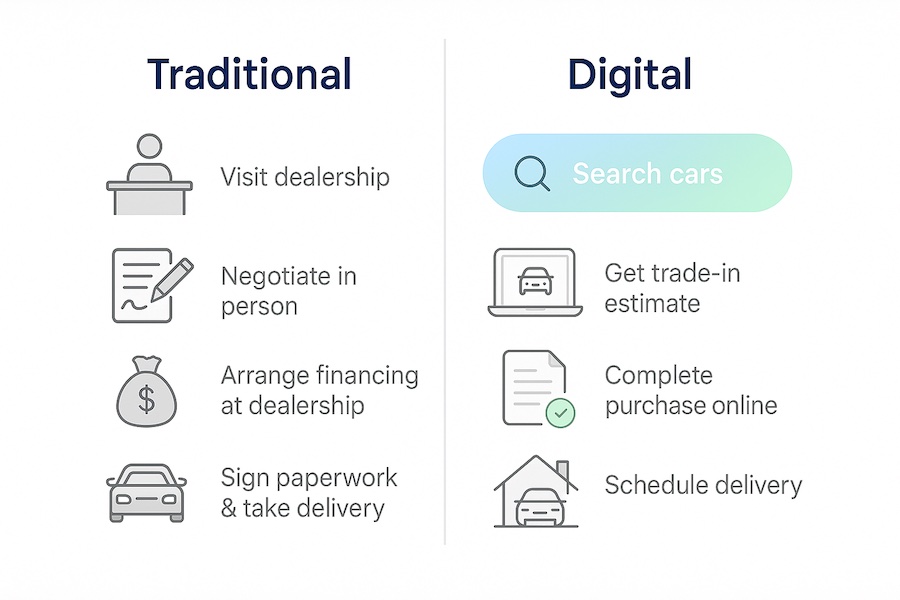Did you know that by 2025, 25% of global passenger car sales are expected to occur online? Imagine purchasing your next car entirely online, from researching models and securing financing to scheduling a test drive and arranging home delivery - all without stepping foot in a dealership. The automotive industry's digital transformation is not just imminent, it's already underway.
Key Takeaways (TL;DR)
- Digital Transformation in Car Buying: The automotive industry is undergoing a significant shift towards digital platforms, with consumers increasingly preferring online methods for purchasing vehicles.
- Consumer Preferences: Studies indicate that a substantial majority of car buyers begin their journey online, seeking convenience, transparency, and efficiency.
- Industry Adaptation: Automakers and dealerships are investing in digital infrastructure, including virtual showrooms and online financing options, to meet evolving consumer demands.
- Benefits of Digital Platforms: Embracing digital tools enhances customer satisfaction, streamlines operations, and can lead to increased sales conversions.
- Challenges and Considerations: Transitioning to digital requires robust infrastructure, staff training, and a focus on data security to ensure a smooth and secure customer experience.
With advancements in technology and changes in consumer behaviour, it's clear that the era of traditional car buying is coming to an end. In fact, studies show that 88% of customers want some form of online transaction when making a vehicle purchase [1]. Today's consumers expect an efficient, seamless experience that prioritizes convenience and personalisation. This includes everything from researching models to financing and ultimately booking test drives.
This shift towards digital is not just a trend, but a necessity for automotive businesses looking to stay relevant and competitive in the market. This is where Tomorrow’s Journey comes in – we offer a scalable, white-label platform designed to revolutionise vehicle access and management for OEMs, dealer groups, and startups.
Why the automotive world is going digital
Advancements in digital technology are transforming entire industries, and automotive sales are no exception. Gone are the days when car buyers needed to visit dealerships multiple times for research, financing, and negotiations. Instead, today’s consumers prioritise convenience, transparency, and speed above all else. They expect a purchasing experience that fits seamlessly into their digital lives, much like the way they shop for other products online.
The automotive industry must adapt to these shifting expectations to remain competitive. By integrating a fully digital car-buying process, automakers and dealerships can not only meet consumer demands for efficiency and convenience but also establish themselves as forward-thinking leaders in an evolving marketplace. From virtual showrooms to online financing and home delivery, the opportunities for innovation are vast and increasingly necessary.
This article delves into why the future of vehicle purchases hinges on a seamless, end-to-end online experience and outlines actionable steps automotive professionals can take to stay ahead of the curve and thrive in this digital-first era.

The Rise of the Digital Car Buyer
Car buying has entered a new era, driven by technology and changing consumer preferences. Today’s car buyers are more tech-savvy than ever. According to Accenture, 80% of drivers rely on digital tools to research vehicles before making a purchasing decision. But it doesn’t stop there, nearly two-thirds of consumers take it a step further, starting the buying process online. This shift represents a fundamental transformation in how people approach car buying.
With easy-to-use digital tools at their fingertips, consumers now prefer exploring, configuring, and comparing cars online rather than visiting multiple dealerships. Online platforms allow buyers to customise features, compare prices, and even access product reviews, all from the comfort of their homes.
The pandemic played a significant role in accelerating this behaviour. To stay competitive, dealers and automakers have adopted advanced digital solutions, including virtual showrooms, online financing, contactless purchasing options, and home delivery. These innovations not only provide convenience but also create a seamless and transparent buying experience that consumers have come to expect.
The trend toward digital car buying is here to stay. By 2025, 25% of global passenger car sales are expected to take place through online channels. This statistic underscores the urgent need for automotive businesses to adapt to this growing demand for digital experiences.
Those who fail to embrace this shift risk falling behind more agile competitors who are already investing in digital transformation. For automakers and dealerships, the focus must be on creating intuitive, customer-centric digital tools that simplify the car-buying journey and meet the expectations of modern consumers.
Benefits of a fully digital car buying process
A fully digital car buying process represents a significant leap forward in enhancing convenience, improving customer satisfaction, and streamlining operations for both buyers and sellers. By integrating seamless online tools, businesses can create a tailored experience that meets the needs of today’s tech-savvy customers. From browsing inventory and customising vehicles to securing financing and finalising purchases, every step can be done from the comfort of home. This approach not only saves time for consumers but also allows businesses to stay ahead in a competitive market, delivering a modern, efficient, and personalized experience. Let's take a look at some of the benefits that can come with fully digital car-buying processes.
1. Enhanced customer experience
Modern customers value convenience and solutions that fit into their busy lives. A fully digital process allows buyers to browse, compare options, and complete transactions all from the comfort of their own homes—no need for in-person visits or lengthy negotiations.
By giving customers full control over key aspects such as browsing, financing, and delivery, businesses can create a more positive experience. This not only increases customer satisfaction but also strengthens brand loyalty over time, as buyers are more likely to return for future needs.
2. Increased efficiency
Digital platforms streamline and accelerate the entire buying process, from initial inquiries to final delivery. Tasks that once required back-and-forth communication, such as document signing or financing approvals, can now be completed with just a few clicks.
This improved efficiency not only saves time for customers but also frees up resources for businesses, allowing teams to focus on delivering better service and support. A faster, smoother process benefits everyone involved.
3. Higher conversions and sales
Personalised online tools, driven by data and customer insights, can recommend products or vehicles tailored to a buyer's specific preferences and needs. This level of personalisation greatly enhances the shopping experience, making it more seamless and relevant.
When customers see a platform that anticipates their needs and provides a smooth, tailored process, they are more likely to trust the brand and proceed with their purchase. This leads to higher conversion rates, improved sales, and long-term customer relationships.
Essential components of a digital buying platform
A successful digital buying platform is built upon key components that streamline the customer experience while addressing operational efficiency for automotive businesses. These elements work together to create a seamless and customised buying journey, meeting the demands of today’s tech-savvy customers. From intuitive interfaces to robust integration capabilities, understanding these essential features is critical for driving engagement, increasing conversions, and building lasting customer satisfaction. Below, we outline the fundamental components every digital buying platform should prioritise.
Virtual showrooms
Virtual showrooms are transforming the car-buying experience, allowing customers to explore vehicle features online in an interactive way. Buyers can view 360-degree images, customise their options, and even try virtual test drives—all from the comfort of home. Leading brands like Volkswagen and BMW have embraced this technology, offering immersive experiences that make it easier for customers to compare and explore options without stepping foot in a dealership. Virtual showrooms are not only convenient but also help potential buyers make more informed decisions.
Online financing and insurance
Securing loans and insurance is often one of the most stressful parts of buying a car. By digitising and streamlining these processes, brands can remove the friction that deters many buyers. Offering simple, transparent, and efficient online tools to handle financing and insurance not only saves time but also builds buyer confidence. Making these steps easier and more accessible is a critical move for any business looking to improve the overall buying experience.
Home delivery
Imagine a customer choosing their new car online and having it delivered directly to their driveway, hassle-free. Forward-thinking brands like Tesla already offer seamless delivery models that set a new standard for convenience. By providing dependable home delivery options, automakers can build trust, reduce barriers to purchase, and cater to the growing demand for easy, frictionless buying experiences. Taking the car dealership experience directly to customers’ homes is a powerful way to stand out in a competitive market.

READ MORE: The Growing Trend of Online Vehicle Purchases
Challenges to consider before going digital
Transitioning to a digital-first approach in the automotive industry presents significant opportunities but also comes with its own set of challenges. While modernising vehicle access and streamlining operations can deliver immense benefits, it’s crucial to understand and address potential obstacles to ensure a smooth and effective transition. From integrating advanced technologies to managing customer expectations, having a comprehensive strategy is key to overcoming barriers and achieving long-term success. Below are some critical challenges to consider when embarking on your digital transformation journey.
Robust digital infrastructure
Building a seamless online car buying experience starts with a solid, secure digital infrastructure. This involves creating platforms that are fast, reliable, and capable of handling high traffic while securely processing sensitive financial transactions. A dependable system ensures customers can browse, purchase, and complete their transactions without unnecessary delays or technical issues, building trust in the process.
Staff training
Even with the best digital tools, human support remains essential. Sales teams need comprehensive training to handle online inquiries effectively, provide guidance, and assist customers as they navigate through the platform. A well-trained team ensures that the personal touch of customer service is not lost in the digital shift, fostering better user experience and higher satisfaction rates.
Data privacy and security
As online car sales grow, so does the responsibility to safeguard customer data. This means implementing advanced encryption technologies, maintaining secure servers, and ensuring full compliance with data protection regulations like GDPR or CCPA. Failing to protect customer information can result in both reputational damage and legal consequences, making data security a top priority for any digital car sales platform.
READ MORE: Why Gen-Z Will Skip The Traditional Car Buying Journey
Real-world examples of success
The automotive industry is rapidly evolving, and many organisations have already adopted innovative solutions to stay ahead. By leveraging digital-first platforms, scalable models, and AI-driven insights, these companies have transformed vehicle access, improved customer experiences, and achieved measurable results. Below, we explore some standout examples of success in modernising mobility operations.
Tesla
Tesla disrupted the automotive market with its fully direct-to-consumer sales model, eliminating the need for traditional dealerships. Buyers can customize and order their vehicles entirely online, streamlining the purchase process and enhancing convenience. Tesla’s use of data-driven insights and over-the-air updates ensures a seamless customer experience, making its digital strategy a benchmark for automotive businesses worldwide.
Volkswagen in China
Volkswagen’s virtual showroom in China attracted 2.5 million viewers at its peak, demonstrating the power of immersive digital experiences. The showroom allowed customers to explore vehicles in detail, interact with features virtually, and even book test drives. This innovative approach showcased how digital platforms can dramatically expand customer reach, especially in markets with high digital engagement.
Why acting now is crucial
The shift towards digital car buying is more than just a passing trend—it marks a fundamental and permanent change in consumer behaviour. Buyers now expect convenience, efficiency, and seamless online experiences when purchasing vehicles. Dealers and automakers must adapt quickly by prioritising digital solutions to stay competitive in this evolving landscape.
By investing in modern, user-friendly digital platforms, businesses can ensure they remain relevant, deliver exceptional customer experiences, and drive higher sales. From streamlined online inventories to virtual showrooms, these tools are no longer optional—they are essential for success.
Automotive leaders at companies like Hyundai, Volkswagen, and Tesla have already demonstrated the power of an online-first approach, setting new standards for the industry. Their success proves that the future of car buying is digital. Now is the time to follow their lead and make digital transformation a top priority for your business to thrive in this new era.
Explore Our Latest Insights
Discover trends and innovations in the automotive sector.

.png)





